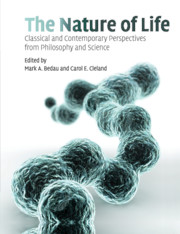Book contents
- Frontmatter
- Contents
- Preface
- Acknowledgments
- Sources
- About the authors
- Introduction
- SECTION I CLASSICAL DISCUSSIONS OF LIFE
- SECTION II THE ORIGIN AND EXTENT OF NATURAL LIFE
- SECTION III ARTIFICIAL LIFE AND SYNTHETIC BIOLOGY
- SECTION IV DEFINING AND EXPLAINING LIFE
- 23 Definitions of life
- 24 The seven pillars of life
- 25 A universal definition of life: autonomy and open-ended evolution
- 26 Does ‘life’ have a definition?
- 27 Sentient symphony
- 28 What is life?
- 29 Universal Darwinism
- 30 What is life? Was Schrödinger right?
- 31 Four puzzles about life
- Supplementary bibliography on life
- Index
24 - The seven pillars of life
Published online by Cambridge University Press: 10 November 2010
- Frontmatter
- Contents
- Preface
- Acknowledgments
- Sources
- About the authors
- Introduction
- SECTION I CLASSICAL DISCUSSIONS OF LIFE
- SECTION II THE ORIGIN AND EXTENT OF NATURAL LIFE
- SECTION III ARTIFICIAL LIFE AND SYNTHETIC BIOLOGY
- SECTION IV DEFINING AND EXPLAINING LIFE
- 23 Definitions of life
- 24 The seven pillars of life
- 25 A universal definition of life: autonomy and open-ended evolution
- 26 Does ‘life’ have a definition?
- 27 Sentient symphony
- 28 What is life?
- 29 Universal Darwinism
- 30 What is life? Was Schrödinger right?
- 31 Four puzzles about life
- Supplementary bibliography on life
- Index
Summary
What is the definition of life? I remember a conference of the scientific elite that sought to answer that question. Is an enzyme alive? Is a virus alive? Is a cell alive? After many hours of launching promising balloons that defined life in a sentence, followed by equally conclusive punctures of these balloons, a solution seemed at hand: “The ability to reproduce—that is the essence characteristic of life” said one statesman of science. Everyone nodded in agreement that the essence of a life was the ability to reproduce, until one small voice was heard. “Then one rabbit is dead. Two rabbits—a male and female—are alive but either one alone is dead.” At that point, we all became convinced that although everyone knows what life is there is no simple definition of life.
If I were forced to rush in where angels fear to tread, I would offer “a living organism is an organized unit, which can carry out metabolic reactions, defend itself against injury, respond to stimuli, and has the capacity to be at least a partner in reproduction.” But I'm not happy with such a brief definition. When allowed more extensive reflection, however, I think the fundamental pillars on which life as we know it is based can be defined. By “pillars” I mean the essential principles—thermodynamic and kinetic—by which a living system operates.
- Type
- Chapter
- Information
- The Nature of LifeClassical and Contemporary Perspectives from Philosophy and Science, pp. 307 - 309Publisher: Cambridge University PressPrint publication year: 2010



